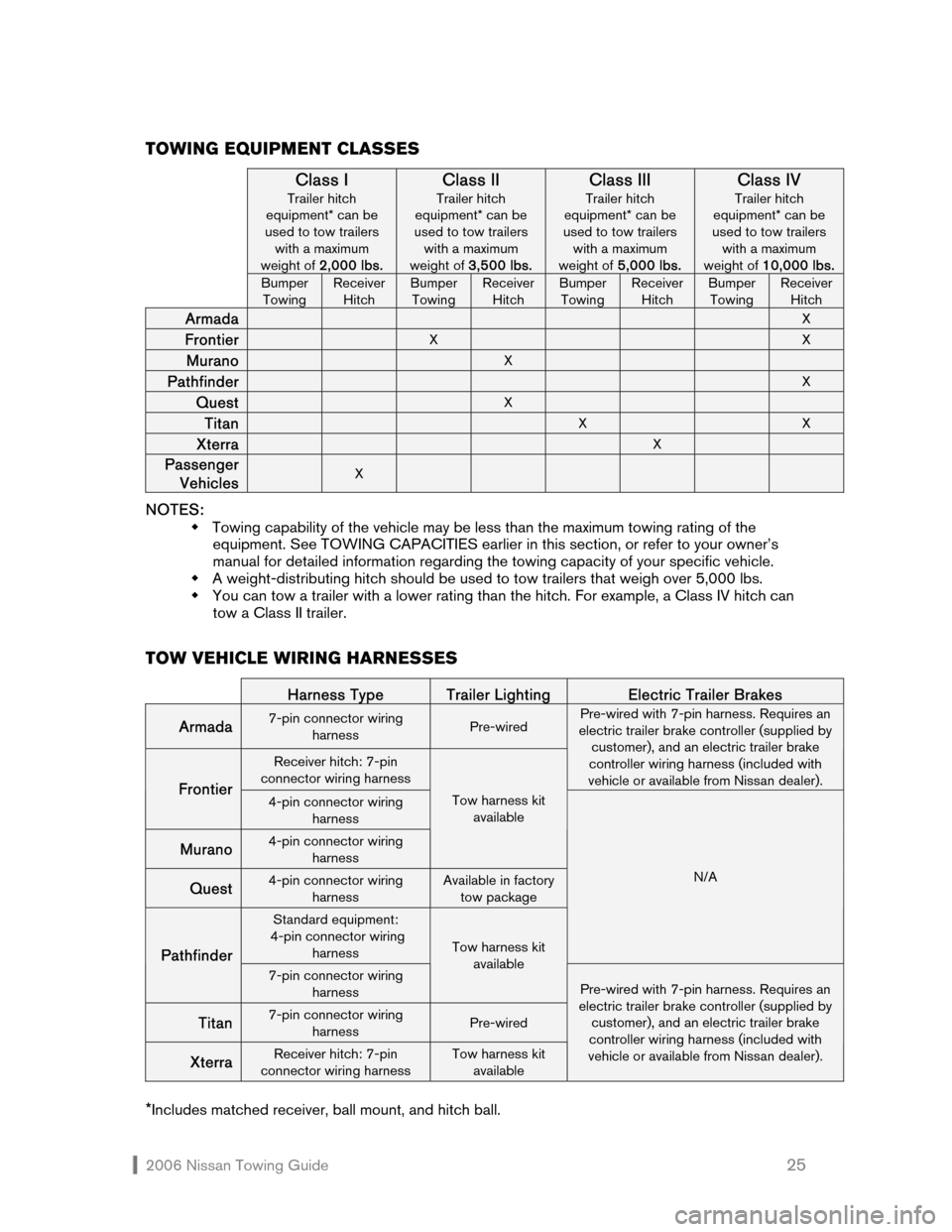2006 NISSAN XTERRA brake
[x] Cancel search: brakePage 20 of 28

2006 Nissan Towing Guide 19 AUTOMATIC CRUISE CONTROL
Do not use cruise control while towing a trailer.
TOW MODE (IF EQUIPPED)
Tow Mode should be used when the vehicle and trailer weight is at least 75% of the
vehicle GCWR. This mode is most useful when towing a heavy trailer or hauling a heavy
load, particularly when stop-and-go traffic, rolling terrain, or a busy parking lot is involved.
Driving the vehicle in Tow Mode with minimal trailer load will not cause any damage;
however, fuel economy may be reduced, and transmission/engine driving characteristics
may feel different.
HILLS – UPGRADES
As the incline increases, shift down to a lower gear to maintain speed and prevent the
engine from lugging. However, for long and steep grades, do not stay in first gear when
driving above 35 mph or in second gear above 58 mph.* The added weight of a trailer
places an increased load on the engine and cooling system, so monitor your coolant
temperature gauge and automatic transmission fluid temperature gauge (if equipped) very
carefully. At the first sign of overheating, pull to the side of the road. See IF YOUR ENGINE
OVERHEATS later in this section for more information.
HILLS – DOWNGRADES
While going downhill, the weight of the trailer pushing on the tow vehicle may decrease
overall stability. Therefore, to maintain adequate control, reduce your speed and shift
to a lower gear.
When descending a hill, also avoid long or repeated use of the brakes as this reduces
their effectiveness and could cause overheating. Shifting to a lower gear instead provides
“engine braking” and reduces the need to brake as frequently.
IF YOUR ENGINE OVERHEATS
A moderate increase in engine operating temperature is normal when towing a trailer. If,
however, the coolant temperature gauge reading is abnormally high, or if you are
experiencing a significant loss of power, or if you hear unusual engine noises,** the engine
may be overheating and you should immediately take the following steps:
1. Pull your vehicle safely over to the side of the road, out of traffic. Apply the parking
brake, and move the gearshift lever to NEUTRAL (manual) or PARK (automatic). DO
NOT STOP THE ENGINE.
*For Murano, see your owner’s manual for information applicable to your vehicle.
**See your owner’s manual for additional indications that your vehicle may be overheating.
Page 22 of 28

2006 Nissan Towing Guide 21
TOWING
GLOSSARY
5TH WHEEL
HITCH Located just forward of the rear axle centerline, this hitch uses a king pin to serve
as the pivot point for the trailer.
BALL MOUNT A bar that holds the hitch ball and is inserted into the hitch receiver. Also
commonly called a drawbar or “stinger.”
BREAKAWAY SWITCH A safety device using a trailer battery that automatically applies the trailer’s
brakes if it should accidentally become separated from the tow vehicle. A
breakaway switch may be used with both electric or surge trailer brake systems.
BUMPER HITCH A reinforced bumper designed to accommodate a hitch ball.
ELECTRIC TRAILER
BRAKES When the brakes on a tow vehicle are applied, an electric current is sent to an
actuator which applies the trailer’s brakes.
ELECTRIC TRAILER
BRAKE CONTROLLER A device that controls the electric trailer brakes.
GOOSENECK HITCH Located just forward of the rear axle centerline, this hitch uses a ball to serve as
the pivot point for the trailer.
GROSS AXLE
WEIGHT RATING (GAWR) The maximum amount of weight each vehicle axle (front and rear) is designed to
safely carry.
GROSS COMBINED
WEIGHT RATING (GCWR) The maximum allowable combined weight of the vehicle and trailer, including
passengers and all cargo.
GROSS VEHICLE
WEIGHT RATING (GVWR) The maximum allowable weight of the vehicle, including passengers, cargo, fuel,
hitch, trailer tongue load, and any optional equipment.
KING PIN
LOAD The amount of trailer (5th wheel or gooseneck) weight pressing down on the tow
vehicle hitch.
HITCH BALL
A ball that connects the trailer to the tow vehicle hitch and provides the means
by which the trailer pivots during cornering. Available in a number of sizes and
weight capacities, it must correspond to the trailer coupler size, and have a
sufficient capacity rating for the trailer being pulled.
RECEIVER HITCH A frame- or structure-mounted hitch with a receiver that allows removal of the
ball mount.
SAFETY CHAINS/CABLES Provides an emergency connection between the tow vehicle and the trailer,
should the trailer become disengaged for any reason.
SURGE BRAKES
Hydraulic-type braking system activated by inertia. As the tow vehicle begins to
brake, the trailer pushes against the hitch ball, consequently activating the trailer
brakes.
TRAILER TONGUE/COUPLER The part of the trailer that extends forward to meet the tow vehicle, and also
carries the coupler assembly.
TRAILER TONGUE
LOAD The amount of trailer (conventional) weight pressing down on the tow vehicle
hitch.
WEIGHT-DISTRIBUTING HITCH
SYSTEM Type of hitch system that helps shift the trailer tongue weight to all trailer tires
and the tow vehicle front tires. Strongly recommended when towing trailers with
a Maximum Trailer Weight greater than 5,000 lbs.
WIRING HARNESS
Provides an electrical connection linking the tow vehicle’s electrical system to
the trailer’s system.
Page 26 of 28

2006 Nissan Towing Guide 25 TOWING EQUIPMENT CLASSES
Class I
Trailer hitch
equipment* can be
used to tow trailers
with a maximum
weight of 2,000 lbs.
Class II
Trailer hitch
equipment* can be
used to tow trailers
with a maximum
weight of 3,500 lbs.
Class III
Trailer hitch
equipment* can be
used to tow trailers
with a maximum
weight of 5,000 lbs.
Class IV
Trailer hitch
equipment* can be
used to tow trailers
with a maximum
weight of 10,000 lbs.
Bumper
Towing
Receiver
Hitch
Bumper
Towing
Receiver
Hitch
Bumper
Towing
Receiver
Hitch
Bumper
Towing
Receiver
Hitch
Armada X
Frontier X X
Murano X
Pathfinder X
Quest X
Titan X X
Xterra X
Passenger
Vehicles X
NOTES:
�Š Towing capability of the vehicle may be less than the maximum towing rating of the
equipment. See TOWING CAPACITIES earlier in this section, or refer to your owner’s
manual for detailed information regarding the towing capacity of your specific vehicle.
�Š A weight-distributing hitch should be used to tow trailers that weigh over 5,000 lbs.
�Š You can tow a trailer with a lower rating than the hitch. For example, a Class IV hitch can
tow a Class II trailer.
TOW VEHICLE WIRING HARNESSES
*Includes matched receiver, ball mount, and hitch ball.
Harness Type Trailer Lighting Electric Trailer Brakes
Armada 7-pin connector wiring
harness Pre-wired
Receiver hitch: 7-pin
connector wiring harness
Pre-wired with 7-pin harness. Requires an
electric trailer brake controller (supplied by
customer), and an electric trailer brake
controller wiring harness (included with
vehicle or available from Nissan dealer). Frontier 4-pin connector wiring
harness
Murano 4-pin connector wiring
harness
Tow harness kit
available
Quest 4-pin connector wiring
harness
Available in factory
tow package
Standard equipment:
4-pin connector wiring
harness
N/A
Pathfinder
7-pin connector wiring
harness
Tow harness kit
available
Titan 7-pin connector wiring
harness Pre-wired
Xterra
Receiver hitch: 7-pin
connector wiring harness
Tow harness kit
available
Pre-wired with 7-pin harness. Requires an
electric trailer brake controller (supplied by
customer), and an electric trailer brake
controller wiring harness (included with
vehicle or available from Nissan dealer).